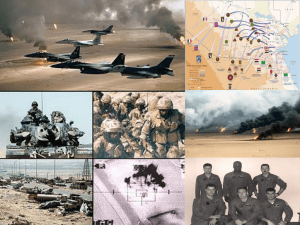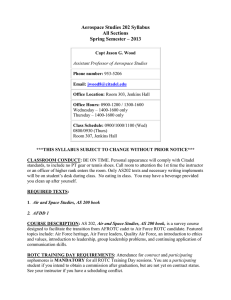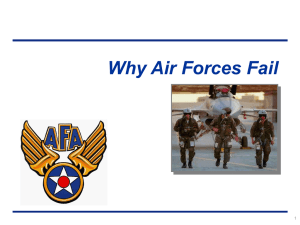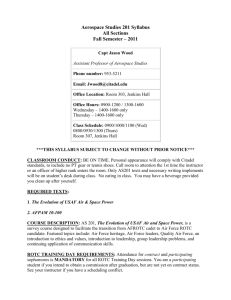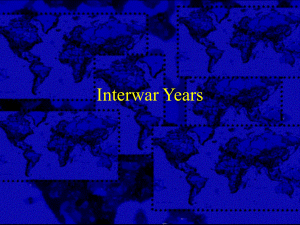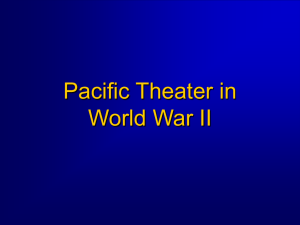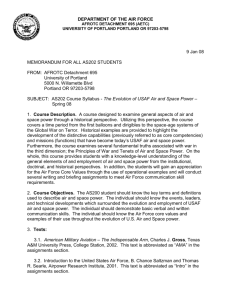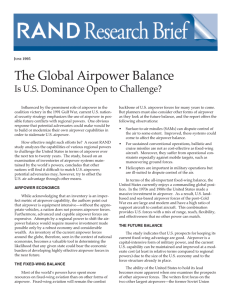THE SOURCE OF BASIC DOCTRINE: FUNDAMENTAL CHARACTERISTICS OF AIRPOWER
advertisement
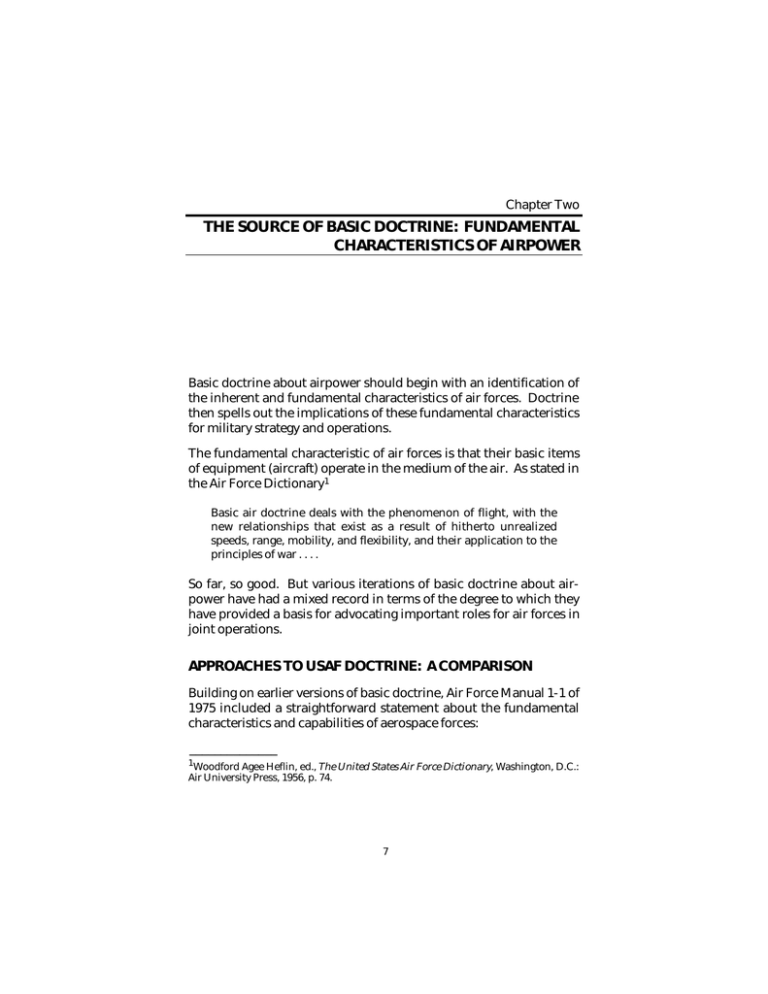
Chapter Two THE SOURCE OF BASIC DOCTRINE: FUNDAMENTAL CHARACTERISTICS OF AIRPOWER Basic doctrine about airpower should begin with an identification of the inherent and fundamental characteristics of air forces. Doctrine then spells out the implications of these fundamental characteristics for military strategy and operations. The fundamental characteristic of air forces is that their basic items of equipment (aircraft) operate in the medium of the air. As stated in the Air Force Dictionary1 Basic air doctrine deals with the phenomenon of flight, with the new relationships that exist as a result of hitherto unrealized speeds, range, mobility, and flexibility, and their application to the principles of war . . . . So far, so good. But various iterations of basic doctrine about airpower have had a mixed record in terms of the degree to which they have provided a basis for advocating important roles for air forces in joint operations. APPROACHES TO USAF DOCTRINE: A COMPARISON Building on earlier versions of basic doctrine, Air Force Manual 1-1 of 1975 included a straightforward statement about the fundamental characteristics and capabilities of aerospace forces: ______________ 1 Woodford Agee Heflin, ed., The United States Air Force Dictionary, Washington, D.C.: Air University Press, 1956, p. 74. 7 8 Defining the Role of Airpower in Joint Missions 2-1. Aerospace. The region above the earth’s surface permits largely unencumbered access to any point on or above the earth. This provides opportunity for direct application of aerospace power against all elements of an enemy’s resources regardless of their location. 2-1. Characteristics and Capabilities of Aerospace Forces. The freedom of operations permitted in aerospace allows aerospace forces to exploit speed, range, altitude, and maneuverability characteristics to a degree not possible by other forces. Unimpeded by natural barriers imposed by land and water masses, aerospace forces can conduct operations rapidly, over great distances in any direction, and enjoy multidimensional maneuvering within the medium of aerospace. Certain distinctive capabilities have evolved through exploitation of these characteristics. Chief among them are: a. Flexibility b. Responsiveness c. Survivability d. Surveillance. As recently as 1990, at least one official Air Force document continued to hew to this basic formulation: This paper provides a perspective on how the unique characteristics of the Air Force—speed, range, flexibility, precision, and lethality— can contribute to underwriting U.S. national security needs in the evolving world order. It also challenges Air Force members, and others in the defense establishment, to think about how we as a nation can best address the role of military forces for the future. And finally, the concepts outlined here . . . provide a framework to conduct future Air Force planning. 2 This approach to defining the characteristics and capabilities of airpower is noteworthy because it is outward looking and expansive: It communicates a recognition that airpower has the potential to support a broad range of the security needs of the United States. It ______________ 2 Donald Rice, Secretary of the Air Force, The Air Force and National Security, 1990, p. 1. The Source of Basic Doctrine: Fundamental Characteristics of Airpower 9 highlights, in clear terms, that which is unique and valuable about air and space forces. Unfortunately, one can also find authoritative Air Force documents that embody a more constraining approach. Perhaps the most egregious example is found in Air Force Manual 1-1 of 1984, which states that: • The basic objective of land forces is to win the land battle. • The basic objective of naval forces is to win the naval battle. • The basic objective of aerospace forces is to win the aerospace battle. This formulation constrains airpower to, at most, a subsidiary role in defeating enemy surface forces and thus runs directly counter to General Fogleman’s conception of a growing role for airpower in warfare. Air Force Manual 1-1 of 1992 dropped this flawed language but introduced new terms that are also problematical: Aerospace forces perform four basic roles: aerospace control, force application, force enhancement, and force support. The 1992 revision of AFM 1-1 does provide an opening for airmen to conceive of a growing role for airpower in joint operations. That opening is something called “force application,” which is said to include, among other things, interdiction. Because interdiction encompasses attacks on forces operating in other mediums— namely, land and sea—it opens up a means within doctrine for airpower to play some role in “the land battle” and “the naval battle.” Nevertheless, the term “force application” lacks the simple directness and ringing clarity of earlier statements. Compare it, for example, to an eloquent statement by Maj Gen Frank M. Andrews in 1938: The airplane is the only weapon which can engage with equal facility, land, sea, and other forces . . . .3 ______________ 3 Quoted in Air Force Manual 1-1, 1984, p. 3-1. 10 Defining the Role of Airpower in Joint Missions This statement suggests that General Andrews, rather than constraining himself to a narrow view of what airpower could accomplish, envisioned the potential capabilities of airpower in all mediums of warfare. Now that the capabilities of airpower have caught up with this vision, the Air Force ought to promulgate a doctrine that, at a minimum, accurately describes this new reality. A WINNING SYLLOGISM This review of past statements about the nature and role of airpower, while admittedly selective and somewhat cursory, suggests two conclusions: • First, statements about the role of airpower by military leaders (past and present) were more encompassing and more compelling than statements found in the last two versions of AFM 1-1. • Second, inherent in the better statements is a three-part syllogism: — Air forces and space forces, by operating in the mediums of air and space, possess the basic characteristics of speed, range, maneuverability, perspective, and mobility. — By exploiting these basic characteristics, modern airpower provides operational capabilities fundamental to the conduct of war, such as mass, maneuver, and situational awareness. — These capabilities portend a major and growing role for airpower in achieving important operational objectives and in protecting and advancing the interests of the United States. Approaching the formulation of doctrine in this manner—from basic characteristics, to capabilities, to roles—yields a conceptual framework that is both logically coherent and consistent with Title 10’s approach (that is, that forces earn roles in missions by virtue of the capabilities they bring to combatant commanders). Such an approach positions air forces (and, hence, the Air Force) favorably for the competition envisaged in Title 10. The following formulation fleshes out this approach and defines the nature and roles of air and space forces: The Source of Basic Doctrine: Fundamental Characteristics of Airpower 11 • Air forces and space forces operate in the mediums of air and space. • The mediums of air and space are continuous around the globe, have no boundaries, are above the mediums of land and sea, permit observation of operations in these other mediums, and provide free access to any point on or above the earth. • Forces operating in the air possess the inherent characteristics of speed, range, maneuverability, perspective, and mobility of large payloads.4 • These inherent characteristics yield operational capabilities central to the conduct of war (rapid and global projection of power, responsiveness, surprise, mass, dispersion, maneuver, and situational awareness). Air forces and space forces thereby provide the opportunity to gain perspective over the entire battle space and to apply power directly against all elements of an enemy’s resources, regardless of their location. • Recent advances in technology have enabled new engagement systems and weapons that yield order-of-magnitude increases in the effectiveness and lethality of weapons delivered by air forces. • By virtue of the nature of their mediums, the inherent characteristics of forces operating in those mediums, and the continuing enhancements to the effectiveness and lethality of these forces, air forces and space forces have the potential to dominate the conduct of enemy operations in all mediums—operations on the land, at sea, in the air, and through space and operations by enemy leaders in exercising sovereignty over their country. • The capabilities offered by modern airpower are especially well suited to meeting many of the demands of U.S. military strategy. Specifically, they allow operations characterized by rapid and long-range projection of effective military power. ______________ 4 Space-based assets share many of the characteristics of air forces. However, the air and space mediums are distinct and call for different types of vehicles. From the perspective of this paper, which focuses on the capabilities of and doctrine for air forces, spaced-based assets provide important capabilities supplementary to those of air (and terrestrial) forces. 12 Defining the Role of Airpower in Joint Missions • It follows that airpower can and should play an increasingly significant role in providing the operational capabilities directed toward controlling all enemy operations, in achieving national security objectives, and in advancing and protecting the security interests of the United States. We do not claim that airpower is today capable of dominating operations in all mediums or in all circumstances. Neither do we believe that the U.S. Air Force should strive for a dominant role in all aspects of military operations. For example, air forces cannot compel a dug-in enemy ground force to move, cannot seize and hold territory, and cannot effectively patrol urban areas. General Fogleman again struck the right note here when he said, in the same speech, that “warfare today, and in the future, will be joint warfare.” Our objective is to advance a doctrinal framework that removes selfimposed limitations on thinking about the potential roles of air and space forces. In addition, the formulation advocated here provides a conceptual grounding for conceiving new approaches to employing air forces and space forces and for identifying priorities for the allocation of resources to modernize those forces. To support the latter activities, it is necessary to disaggregate these broad statements of the role of airpower into operational-level components. This is the subject of the next chapter. A WORD ABOUT “CORE COMPETENCIES” The concept of “core competencies” has acquired some currency recently and has been used in many ways. If this term is to have any value in the realm of doctrine, it should be applied to those qualities of different types of forces that are unique and enduring. If we adopt this standard for the use of the term, the core competency of air and space forces—that which sets them apart from other types of forces—is that they are indeed air and space forces: These forces, by nature, fly through the air and traverse space—the mediums of choice for accomplishing many critical operational tasks. Used in this way, the concept of a core competency reinforces the approach to doctrine advocated above. That is, the core competency of air and space forces—their ability to traverse air and space—gives The Source of Basic Doctrine: Fundamental Characteristics of Airpower 13 them inherent characteristics of speed, range, mobility, and perspective. These inherent characteristics, in turn, make it possible for air and space forces to possess the fundamental capabilities of projection, responsiveness, maneuver, mass, and situation awareness. Attempting to define the core competencies of these forces in more specific terms than this (for example, “air and space superiority,” “information superiority”) runs the risk of overspecifying and, hence, limiting the potential employment of air and space forces. It would be awkward for the Air Force to proclaim that its units possessed a core competency of “land superiority,” even though these units can, in fact, dominate operations on the land in many cases. An approach to defining these forces in terms of inherent characteristics and capabilities seems preferable to “core competencies” for another reason: The capabilities of a force or a force element can be measured and compared to those of other forces. Core competencies, by contrast, are intended to be unique to each service and, hence, by definition, do not lend themselves well to comparisons. As defined thus far, core competencies are also too general to permit meaningful comparison. If one believes that air forces compare favorably to other types of forces in terms of their capability to perform key operational tasks, it follows that the Air Force should strive to define these forces in terms that invite, rather than avoid, quantification and comparison.
